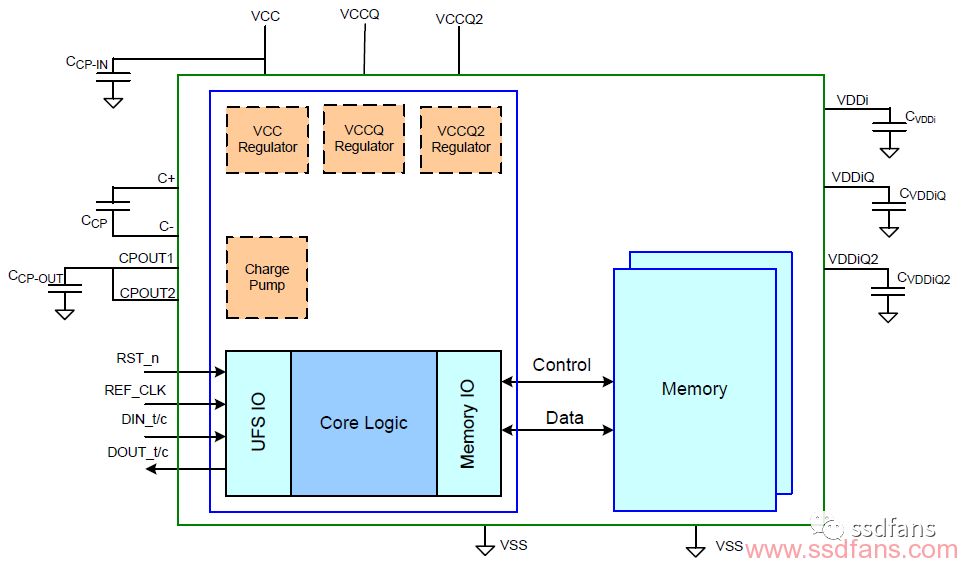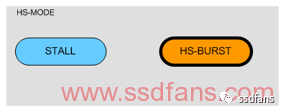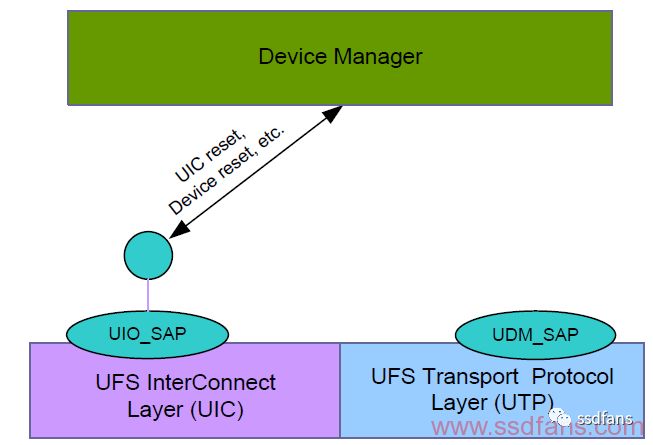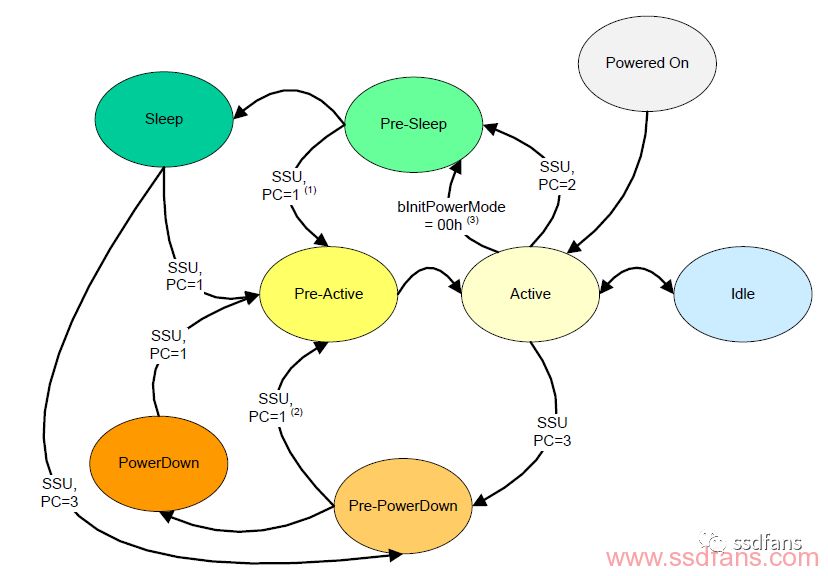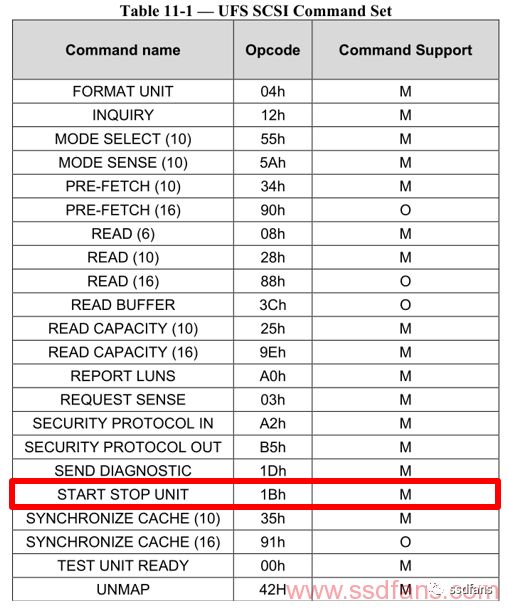FS is a mobile phone storage device, so it has high power consumption requirements. Let's take a look at the power management of UFS. Three power supply voltages, VCC, VCCQ and VCCQ2, respectively supply power to UFS equipment modules. UFS equipment mainly includes three parts: front-end UFS interface (M-PHY), UFS controller and flash media (Memory module in the picture). VCC supplies power to the flash memory medium, VCCQ generally supplies power to the flash memory I/O interface and UFS controller, and VCCQ2 generally supplies power to M-PHY or some other low-voltage modules. In UFS2.1, the three voltage values ​​are: We know that the UFS protocol uses MIPI's M-PHY as the physical layer and UniPro as its data link layer. M-PHY has high speed mode (High Speed ​​Mode, HS-MODE) and low speed mode (Low Speed ​​Mode, LS-MODE). Among them, in high-speed mode, M-PHY has two states: STALL and HS-BURST. In low-speed mode, M-PHY has three states: LINE-CFG, SLEEP and PWM-BURST. When there is no data transmission on the link, M-PHY will automatically switch to STALL or SLEEP state, these two states are power saving states. In addition, M-PHY has a more power-saving state, which is HIBERN8 (Hibernate, sleep state). In this state, M-PHY is extremely power-saving. It is impossible for the UFS host and the UFS device to exchange data all the time, and there are always times when they are free. When the UFS host does not read or write to the UFS device, it will put the mutual link into a sleep state, namely HIBERN8. How does the UFS host notify the M-PHY to switch to the sleep state? As mentioned earlier, the device manager can skip the transport layer and directly manage and control the interconnection layer: The host device manager can directly communicate with the UFS interconnection layer (UIC, MIPI's UniPro and M-PHY) through primitives. In addition to the reset primitives shown in the figure above, UFS also includes primitives for UIC to enter and exit hibernation: DME_HIBERNATE_ENTER and DME_HIBERNATE_EXIT. This is a power saving mode for the link between the UFS host and the device. For UFS devices, the link is only a part of the entire UFS device. Whether a UFS device saves power, in addition to looking at its link, you also need to consider whether the UFS controller, storage media, etc. save power, that is, whether the entire UFS device has good power management. UFS defines 4 basic power modes: Active, Idle, Power Down and Sleep (AIDS for short), plus 3 transitional power modes: Pre-Active, Pre-Sleep and Pre-PowerDown, a total of 7 power modes . Very 4+3! Active mode: UFS device is in this state when executing commands or doing background operations (Background Operation); Idle mode: When the UFS device is idle, that is, there is neither a command from the UFS host nor a background task to process, the device is in this state; Sleep mode: I am dozing off idle. In sleep mode, the VCC power supply may be cut off (depending on the design of the UFS device). VCC generally supplies power to the flash memory, that is, cuts off the power supply to the flash memory. Power Down mode: In power-down mode, all power supplies VCC, VCCQ and VCCQ2 may be cut off (depending on the design of the UFS device). This mode is the most power-saving power mode. The conversion between these modes is as follows: We have seen that many of the trigger modes are SSU, so what is SSU? SSU is the abbreviation of Start Stop Unit. It is a basic command in the UFS protocol. The host uses it to switch the power mode of the UFS device. Refer to UFS spec for specific commands. Note that these power consumption states of UFS devices are independent of the STALL, SLEEP or HIBERN8 states of the M-PHY interface mentioned above, and there is no necessary connection between the two. For example, the current M-PHY is in the HIBERN8 state, and the UFS device can be in any of the above states. For example, the UFS device can be in the Active state. There is no requirement to say that you sleep and I have to follow it. A good employee is not a boss who pushes and then takes a step forward, but can take the initiative to take on some tasks. A good UFS device does not wait for the host to send a power switch command to enter the power saving mode, but can take the initiative to do something to save power. The following are the qualities that an excellent UFS equipment needs to possess. For example, when the UFS is just powered on, the UFS enters the Active state. If there is no command from the host for a period of time, and there is no internal background task to process, the UFS device will enter the Idle state. Idle means that there is nothing to do. At this time, the host did not send any SSU command to request the UFS device to enter the specified state (the boss did not ask you to do anything). For a good UFS device, you must think about how to save power at this time. . For example, if the current M-PHY is in the HIBERN8 state, it means that the host will not currently access the UFS device. Therefore, the UFS device can do some energy-saving designs: for example, save the software and hardware context of the current UFS device to the flash memory, and then cut off all power to To achieve the purpose of power saving. After the M-PHY interface exits the HIBERN8 state, the UFS device is powered on, and then the software and hardware context is loaded and run. The boss did not ask you to do the work. You took the initiative to do the work. Which boss does not like such employees? Power saving and user experience (speed response to commands) is actually a contradiction. Because if the UFS device sleeps, it cannot respond to host commands in time, because it needs to exit sleep first (for example, it needs to reload the context saved before sleep, which often takes time), and then respond to host commands. Sleeping is a technical activity. While pursuing maximum energy saving, it must also take into account the user experience. Uv Curing Hydrogel Film,Glass Protector,Matte Frosted Antiglare Full Cover Screen Protector,Cut Screen Protector Glass Shenzhen TUOLI Electronic Technology Co., Ltd. , https://www.hydrogelprotectors.com